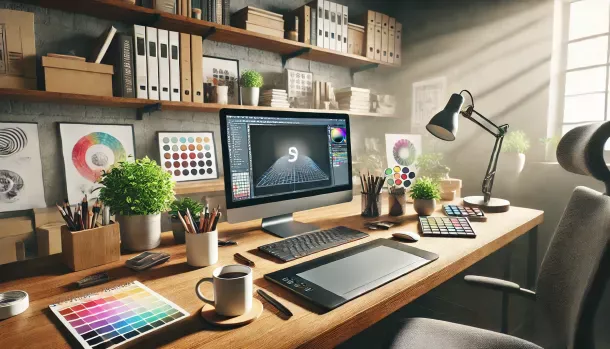The Evolution of Graphic Design: From Print to Digital
The Evolution of Graphic Design: From Print to Digital
Graphic design is a field that has undergone tremendous changes over the years. What started as a manual craft involving paper, ink, and typesetting has transformed into a digital practice that now permeates nearly every aspect of modern life. This evolution reflects broader shifts in technology, culture, and communication. In this article, we will explore the history of graphic design, examining its journey from print to digital, and how these changes have impacted the profession and its practitioners.
The Origins of Graphic Design: The Print Era
Graphic design, as we know it today, has its roots in the print industry. The term “graphic design” was coined in the 1920s, but the practice itself dates back centuries. Early forms of graphic design can be traced to the invention of the printing press by Johannes Gutenberg in the 15th century. The printing press revolutionized the way information was disseminated, making books and other printed materials more accessible to the masses.
During the Renaissance, the role of the designer became more defined. Artists and craftsmen who specialized in typography, illustration, and layout began to create printed materials that were not only functional but also visually appealing. This period saw the development of early typefaces and the use of grids to organize content, laying the foundation for modern graphic design principles.
The Industrial Revolution of the 18th and 19th centuries further accelerated the growth of graphic design. The rise of mass production and the proliferation of printed materials, such as newspapers, posters, and advertisements, created a demand for skilled designers. This era also saw the birth of the first design agencies, where teams of artists and typographers collaborated to produce high-quality printed materials.
The Transition to Digital: A New Era in Graphic Design
The advent of computers in the late 20th century marked a significant turning point in the history of graphic design. The introduction of desktop publishing software, such as Adobe Illustrator and Photoshop in the 1980s, allowed designers to create and manipulate images digitally. This shift from manual to digital design tools transformed the industry, making the design process faster, more efficient, and accessible to a wider audience.
Digital design also introduced new possibilities for creativity and experimentation. Designers could now work with a broader range of colors, textures, and effects that were previously impossible or impractical with traditional print methods. The ability to easily edit and iterate on designs also encouraged a more experimental approach, leading to the development of new styles and trends.
As the internet became more widespread in the 1990s, the role of graphic designers expanded to include web design. This new medium required designers to think differently about how they presented information. Unlike print, which is static, digital media is dynamic and interactive. Designers had to consider factors such as screen resolution, user interface (UI) design, and user experience (UX) when creating websites and digital content.
The transition to digital also democratized graphic design. Tools that were once expensive and difficult to access became more affordable and user-friendly. Platforms like Canva and Adobe Spark made it possible for individuals with little to no design experience to create professional-looking graphics. This shift has blurred the lines between professional and amateur design, leading to an explosion of visual content on the internet and social media.
The Impact of Digitalization on Graphic Design
Digitalization has not only changed the tools and processes used in graphic design but also the nature of the work itself. The rise of digital media has led to the creation of new job roles and specializations within the field. Web designers, UX/UI designers, motion graphic designers, and digital illustrators are just a few examples of careers that have emerged in the digital age.
One of the most significant impacts of digitalization is the shift from static to dynamic content. Motion graphics, animations, and interactive designs have become increasingly popular as brands seek to engage audiences in more immersive and memorable ways. The rise of social media platforms like Instagram, TikTok, and YouTube has further fueled this trend, as these platforms prioritize video and animated content.
Moreover, the digital age has introduced the concept of responsive design, which ensures that content looks good and functions well on a variety of devices, from desktop computers to smartphones and tablets. This has added a layer of complexity to the design process, as designers must now consider how their work will be viewed and interacted with across different screen sizes and resolutions.
The global nature of the internet has also led to a greater emphasis on localization and cultural sensitivity in design. Designers must now consider how their work will be perceived by diverse audiences around the world, taking into account factors such as language, cultural norms, and color symbolism.
The Role of Technology in Shaping Modern Graphic Design
Technology has played a pivotal role in shaping the evolution of graphic design. The introduction of vector graphics, for example, revolutionized the way designers create logos, icons, and other scalable graphics. Vector graphics are made up of points, lines, and curves that can be infinitely scaled without losing quality, making them ideal for digital media.
Artificial intelligence (AI) and machine learning are also starting to make their mark on the field. AI-powered design tools can automate repetitive tasks, such as resizing images or selecting color palettes, freeing up designers to focus on more creative aspects of their work. Some AI tools can even generate designs based on inputted data or preferences, opening up new possibilities for personalization and customization.
The rise of virtual reality (VR) and augmented reality (AR) is another area where technology is pushing the boundaries of graphic design. These immersive technologies offer new opportunities for designers to create interactive experiences that go beyond traditional screens. For example, AR can be used to create virtual try-on experiences for fashion brands, while VR can transport users into fully immersive digital environments.
The Future of Graphic Design: Trends and Predictions
As we look to the future, it is clear that graphic design will continue to evolve alongside advances in technology. One trend that is likely to continue is the move towards more personalized and data-driven design. As brands seek to connect with consumers on a deeper level, designers will need to harness the power of data to create more targeted and relevant content.
Sustainability is another trend that is expected to shape the future of graphic design. As consumers become more environmentally conscious, brands will need to reflect these values in their visual identity. This could mean using eco-friendly materials for printed materials or designing digital content that reduces energy consumption.
The continued rise of remote work is also likely to have an impact on the field. With more designers working from home, collaboration tools and platforms will become increasingly important. Virtual reality could play a role in this, offering new ways for designers to collaborate in immersive digital environments.
Finally, the lines between graphic design, art, and technology will continue to blur. As new technologies emerge, designers will need to adapt and expand their skill sets to stay relevant in a rapidly changing landscape. This could mean learning to code, experimenting with new mediums like 3D printing, or exploring the creative possibilities of AI and machine learning.
Conclusion
The evolution of graphic design from print to digital has been nothing short of transformative. What was once a manual, labor-intensive craft has become a dynamic and ever-evolving field that is deeply intertwined with technology. As we move further into the digital age, graphic design will continue to adapt and grow, reflecting the changing needs and desires of society. For designers, this presents both challenges and opportunities, as they navigate a landscape that is constantly in flux. However, one thing is certain: the future of graphic design is bright, and its impact on the world will only continue to grow.


